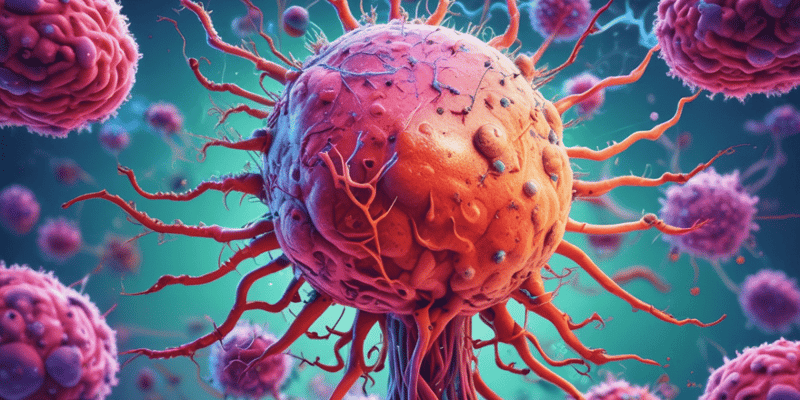Podcast
Questions and Answers
Which of the following is NOT a characteristic of the nonspecific (innate) defense system?
Which of the following is NOT a characteristic of the nonspecific (innate) defense system?
What is the primary function of the acidic skin secretions (acid mantle) in the nonspecific defense system?
What is the primary function of the acidic skin secretions (acid mantle) in the nonspecific defense system?
Which of the following is NOT a mechanism by which the mucous membranes contribute to the nonspecific defense system?
Which of the following is NOT a mechanism by which the mucous membranes contribute to the nonspecific defense system?
What is the role of opsonization in phagocytosis?
What is the role of opsonization in phagocytosis?
Signup and view all the answers
Which of the following is a characteristic of wandering macrophages?
Which of the following is a characteristic of wandering macrophages?
Signup and view all the answers
Which of the following statements accurately describes the process of respiratory burst?
Which of the following statements accurately describes the process of respiratory burst?
Signup and view all the answers
What is the primary difference between nonspecific (innate) and specific (adaptive) defense systems?
What is the primary difference between nonspecific (innate) and specific (adaptive) defense systems?
Signup and view all the answers
Which of the following is NOT considered a component of the nonspecific (innate) defense system?
Which of the following is NOT considered a component of the nonspecific (innate) defense system?
Signup and view all the answers
What is the primary role of opsonization in the immune response?
What is the primary role of opsonization in the immune response?
Signup and view all the answers
Which statement accurately describes Natural Killer (NK) cells?
Which statement accurately describes Natural Killer (NK) cells?
Signup and view all the answers
What is the main function of inflammation in the body?
What is the main function of inflammation in the body?
Signup and view all the answers
What is the immediate effect of increased permeability of capillaries during an inflammatory response?
What is the immediate effect of increased permeability of capillaries during an inflammatory response?
Signup and view all the answers
How does the inflammatory response contribute to pain sensation?
How does the inflammatory response contribute to pain sensation?
Signup and view all the answers
Which role do inflammatory chemicals play during an injury?
Which role do inflammatory chemicals play during an injury?
Signup and view all the answers
What is a notable characteristic of NK cells in comparison to phagocytes?
What is a notable characteristic of NK cells in comparison to phagocytes?
Signup and view all the answers
What is the significance of clotting proteins in the context of inflammation?
What is the significance of clotting proteins in the context of inflammation?
Signup and view all the answers
Study Notes
Defense Systems
- Nonspecific (innate) defense system: Immediate response to protect the body from foreign substances; always ready.
- Specific (adaptive) defense system (Immune System): Targets foreign substances with delayed response; key cells include macrophages and lymphocytes.
Nonspecific Defense System
Surface Membrane Barriers
- Skin: Epidermis with keratin acts as a physical barrier; resistant to weak acids/bases and bacterial enzymes/toxins.
- Acid mantle: Acidic skin secretions inhibit bacterial growth.
-
Mucous membranes: Provide physical barriers and chemical secretions to trap pathogens.
- Stomach: HCL and protein-digesting enzymes aid in pathogen destruction.
- Vagina: Acidic secretions protect against infections.
- Saliva and Lacrimal fluid: Contain lysozyme, an antibacterial enzyme.
- Mucus: Traps bacteria in respiratory and digestive pathways.
Nonspecific Cellular and Chemical Defenses
-
Species Resistance: Certain species have innate immunity against specific pathogens.
-
Phagocytes: Main types include macrophages (derived from monocytes).
- Can be wandering or fixed in tissues.
- Function through phagocytosis and respiratory bursts.
- Require adhesion to foreign substances; opsonization enhances adhesion by coating microbes with proteins.
-
Natural Killer (NK) Cells: Patrol blood and lymph for threats.
- Lyse and kill cancer cells and virus-infected cells before full immune activation.
- Not phagocytic; attack through membrane disruption and release of perforins.
Inflammation
-
Triggered by tissue injury, infections, or damage from various sources.
-
Purpose:
- Prevents and limits the spread of damaging agents.
- Disposes of cellular debris and pathogens.
- Initiates repair processes.
-
Inflammatory chemicals released by damaged cells lead to:
- Vasodilation: Increased blood flow to the area causes heat and redness.
- Increased capillary permeability: Permits fluid entry into interstitial spaces; leads to edema and pain from pressure on nerves.
-
Importance of Inflammation:
- Dilutes harmful substances.
- Brings oxygen and nutrients essential for repair.
- Facilitates entry of clotting proteins to isolate and protect the injury site.
Studying That Suits You
Use AI to generate personalized quizzes and flashcards to suit your learning preferences.
Description
This quiz covers the nonspecific and specific defense systems of the body, including external body membranes, chemical and cellular defenses, and the immune system.




